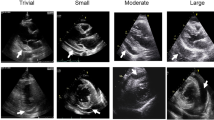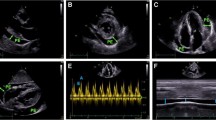Abstract
Purpose of Review
The purpose of this paper is to review current approaches to the diagnosis and treatment of pericardial effusions and cardiac tamponade.
Recent Findings
Recent recommendations from the American Society of Echocardiography and the European Society of Cardiology have refined our approaches to the patient with pericardial effusion and cardiac tamponade, but significant knowledge gaps remain. New diagnostic and triage strategies have been proposed, and recent data have advanced our ability to assess the presence and size of a pericardial effusion, assess its hemodynamic impact, and establish its cause.
Summary
Despite these recent findings, there is a paucity of evidence-based data to guide the management of pericardial effusion and cardiac tamponade. While the first-line function of echocardiography in managing these disorders is unquestioned, there are increasing niche roles for multimodality imaging.






Similar content being viewed by others
References
Papers of Particular Interest, Published Recently, Have Been Highlighted as: • Of importance, •• Of major Importance
• Adler Y, Charron P, Imazio M, Badano L, Baron-Esquivias G, Bogaert J, et al. 2015 ESC guidelines for the diagnosis and management of pericardial diseases: the Task force for the diagnosis and management of pericardial diseases of the European Society of Cardiology (ESC) endorsed by: the European Association for Cardio-Thoracic Surgery (EACTS). Eur Heart J. 2015;36:2921–64. An exhaustive, authoritative document offering guidelines and recommendations (most representing a consensus of experts and/or small studies, retrospective studies, and registries) for all manifestations of pericardial disease.
Hoit BD. Diagnosis and treatment of pericardial effusion. www.uptodate.com. In: UpToDate, Post TW (Ed), UpToDate, Waltham, MA. (Accessed on 3/23/17.) Copyright © 2016 UpToDate, Inc. For more information visit www.uptodate.com.
• Imazio M, Adler Y. Management of pericardial effusion. Eur Heart J. 2013;34:1186–97. A critical evaluation of the pathophysiology, clinical presentation diagnosis, treatment, and follow-up of pericardial effusions.
Permanyer-Miralda G, Sagrista-Sauleda J, Soler-Soler J. Primary acute pericardial disease: a prospective series of 231 consecutive patients. Am J Cardiol. 1985;56:623–30.
Sagrista-Sauleda J, Merce J, Permanyer-Maralda G, Soler-Soler J. Clinical clues to the causes of large pericardial effusions. Am J Med. 2000;109:95–101.
Corey GR, Campbell PT, VanTrigt P, Kenney RT, O’Connor CM, Sheikh KH, et al. Etiology of large pericardial effusion. Am J Med. 1993;95:209–13.
Levy PY, Corey R, Berger P, Habib G, Bonnet JL, Levy S, et al. Etiologic diagnosis of 204 pericardial effusion. Medicine (Baltimore). 2003;82:385–91.
• Ma W, Liu J, Chen S, Chen S, Zheng Y, Ye S, et al. Causes of moderate to large pericardial effusion requiring pericardiocentesis in 140 Han Chinese patients. Herz. 2012;37:183–7. A contemporary review of the clinical characteristics and etiologies of moderate to large pericardial effusions that required drainage. Malignancy, infection, and iatrogenic were the three leading causes.
Seferovic PM, Ristic AD, Imazio M, Maksimovic R, Simeunovic D, Trinchero R, et al. Management strategies in pericardial emergencies. Herz. 2006;31:891–900.
Kuvin JT, Harati NA, Pandian NG, Bojar RM, Khabbaz KR. Postoperative cardiac tamponade in the modern surgical era. Ann Thorac Surg. 2002;74:1148–53.
•• Meurin P, LeLay-Kubas S, Pierre B, Pereira H, Pavy B, Iliou MC, et al. Colchicine for post-operative pericardial effusion. J Am Coll Cardiol. 2015;66:1198–9. A letter which describes the preliminary results of the POPE-2 study. In patients with a moderate to large pericardial effusion persisting one week after cardiac surgery, colchicine had no significant effect on the size of the effusion.
Freeman GL, LeWinter MM. Pericardial adaptations during chronic cardiac dilation in dogs. Circ Res. 1984;54:294–300.
•• Klein AL, Abbara S, Agler DA, Appleton CP, Asher CR, Hoit B, et al. American Society of Echocardiography clinical recommendations for multimodality cardiovascular imaging of patients with pericardial disease: endorsed by the Society for Cardiovascular Magnetic Resonance and Society of Cardiovascular Computed Tomography. J Am Soc Echocardiogr. 2013;26:965–1012. A detailed, well-illustrated expert consensus statement from the ASE offering recommendations for integrated multimodality imaging in all manifestations of pericardial disease.
Verhaert D, Gabriel RS, Johnston D, Lytle BW, Desai MY, Klein AL. The role of multimodality imaging in the management of pericardial diseases. Circ Cardiovasc Imaging. 2010;3:333–43.
Shabetai R. Pericardial effusion: haemodynamic spectrum. Heart. 2004;90:255–6.
Brown J, MacKinnon D, King A, Vanderbush E. Elevated arterial blood pressure in cardiac tamponade. N Engl J Med. 1992;327:463–6.
Reddy PS, Curtiss EI, O'Toole JD, Shaver JA. Cardiac tamponade: hemodynamic observations in man. Circulation. 1978;58:265–72.
Cogswell TL, Bernath GA, Raff H, Hoffmann RG, Klopfenstein HS. Total peripheral resistance during cardiac tamponade: adrenergic and angiotensin roles. Am J Phys. 1986;251:R916–22.
Sagrista-Sauleda J, Angel J, Sambola A, Alguersuari J, Permanyer-Miralda G, Soler-Soler J. Low-pressure cardiac tamponade: clinical and hemodynamic profile. Circulation. 2006;114:945–52.
Vaska K, Wann LS, Sagar K, Klopfenstein HS. Pleural effusion as a cause of right ventricular diastolic collapse. Circulation. 1992;86:609–17.
• Ristic AD, Imazio M, Adler Y, Anastasakis A, Badano LP, Brucato A, et al. Triage strategy for urgent management of cardiac tamponade: a position statement of the European Society of Cardiology Working Group on Myocardial and Pericardial Diseases. Eur Heart J. 2014;35:2279–84. A proposal for a step-wise scoring system based on the etiology, clinical presentation and imaging of pericardial effusions that identifies high risk patients requiring urgent pericardiocentesis and those patients that should be transferred to hospitals specializing in pericardial disease.
Himelman RB, Kircher B, Rockey DC, Schiller NB. Inferior vena cava plethora with blunted respiratory response: a sensitive echocardiographic sign of cardiac tamponade. J Am Coll Cardiol. 1988;12:1470–7.
Singh S, Wann LS, Klopfenstein HS, Hartz A, Brooks HL. Usefulness of right ventricular diastolic collapse in diagnosing cardiac tamponade and comparison to pulsus paradoxus. Am J Cardiol. 1986;57:652–6.
Gillam LD, Guyer DE, Gibson TC, King ME, Marshall JE, Weyman AE. Hydrodynamic compression of the right atrium: a new echocardiographic sign of cardiac tamponade. Circulation. 1983;68:294–301.
Leimgruber PP, Klopfenstein HS, Wann LS, Brooks HL. The hemodynamic derangement associated with right ventricular diastolic collapse in cardiac tamponade: an experimental echocardiographic study. Circulation. 1983;68:612–20.
Merce J, Sagrista-Sauleda J, Permanyer-Miralda G, Evangelista A, Soler-Soler J. Correlation between clinical and Doppler echocardiographic findings in patients with moderate and large pericardial effusion: implications for the diagnosis of cardiac tamponade. Am Heart J. 1999;138:759–64.
Hoit BD, Fowler NO. Influence of acute right ventricular dysfunction on cardiac tamponade. J Am Coll Cardiol. 1991;18:1787–93.
Hoit BD, Gabel M, Fowler NO. Cardiac tamponade in left ventricular dysfunction. Circulation. 1990;82:1370–6.
Chuttani K, Tischler MD, Pandian NG, Lee RT, Mohanty PK. Diagnosis of cardiac tamponade after cardiac surgery: relative value of clinical, echocardiographic, and hemodynamic signs. Am Heart J. 1994;127:913–8.
Hoit BD, Shaw D. The paradoxical pulse in tamponade: mechanisms and echocardiographic correlates. Echocardiography. 1994;11:477–87.
Seferović PM, Ristić AD, Maksimović R, Tatic V, Ostojic M, Kanjuh V. Diagnostic value of pericardial biopsy: improvement with extensive sampling enabled by pericardioscopy. Circulation. 2003;107:978–83.
Maisch B, Ristić AD, Pankuweit S. Intrapericardial treatment of autoreactive pericardial effusion with triamcinolone; the way to avoid side effects of systemic corticosteroid therapy. Eur Heart J. 2002;23:1503–8.
Ben-Horin S, Bank I, Shinfeld A, Kachel E, Guetta V, Livneh A. Diagnostic value of the biochemical composition of pericardial effusions in patients undergoing pericardiocentesis. Am J Cardiol. 2007;99:1294–7.
Tsang TS, Enriquez-Sarano M, Freeman WK, Barnes ME, Sinak LJ, Gersh BJ, et al. Consecutive 1127 therapeutic echocardiographically guided pericardiocentesis: clinical profile, practice patterns, and outcomes spanning 21 years. Mayo Clin Proc. 2002;77:429–36.
• Imazio M, Belli R, Beqaraj F, et al. DRainage Or Pericardiocentesis alone for recurrent nonmalignant, nonbacterial pericardial effusions requiring intervention: rationale and design of the DROP trial, a randomized, open-label, multicenter study. J Cardiovasc Med. 2014;15:510–4. Methodology of a multicenter trial that is randomizing patients with hemodynamically significant nonmalignant, nonbacterial pericardial effusions to pericardiocentesis vs. pericardiocentesis plus prolonged drainage. The primary end-points are incidence of recurrent pericardial effusion and the need for additional pericardiocentesis or cardiac surgery at 12 months.
Ziskind AA, Pearce AC, Lemmon CC, Burstein S, Gimple LW, Herrmann HC, et al. Percutaneous balloon pericardiotomy for the treatment of cardiac tamponade and large pericardial effusions: description of technique and report of the first 50 cases. J Am Coll Cardiol. 1993;21:1–5.
Mitiku TY, Heidenreich PA. A small pericardial effusion is a marker of increased mortality. Am Heart J. 2011;161:152–7.
• Frohlich GM, Keller P, Schmid F, et al. Haemodynamically irrelevant pericardial effusion is associated with increased mortality in patients with chronic heart failure. Eur Heart J. 2013;34:1414–23. In this retrospective observational study of nearly 900 patients with heart failure, the presence of a hemodynamically insignificant pericardial effusion was independently associated with a ~ 2-fold hazard of death at one year.
Sagristà-Sauleda J, Angel J, Permanyer-Miralda G, Soler-Soler J. Long-term follow-up of idiopathic chronic pericardial effusion. N Engl J Med. 1999;341:2054–9.
Hoit BD. Diagnosis and management of pericardial disease. J Intensive Care Med. 2000;15(1):14–28.
Author information
Authors and Affiliations
Corresponding author
Ethics declarations
Conflict of Interest
Brian D. Hoit declares that he has no conflict of interest.
Human and Animal Rights and Informed Consent
This article does not contain any studies with human or animal subjects performed by any of the authors.
Additional information
This article is part of the Topical Collection on Pericardial Disease
Rights and permissions
About this article
Cite this article
Hoit, B.D. Pericardial Effusion and Cardiac Tamponade in the New Millennium. Curr Cardiol Rep 19, 57 (2017). https://doi.org/10.1007/s11886-017-0867-5
Published:
DOI: https://doi.org/10.1007/s11886-017-0867-5




